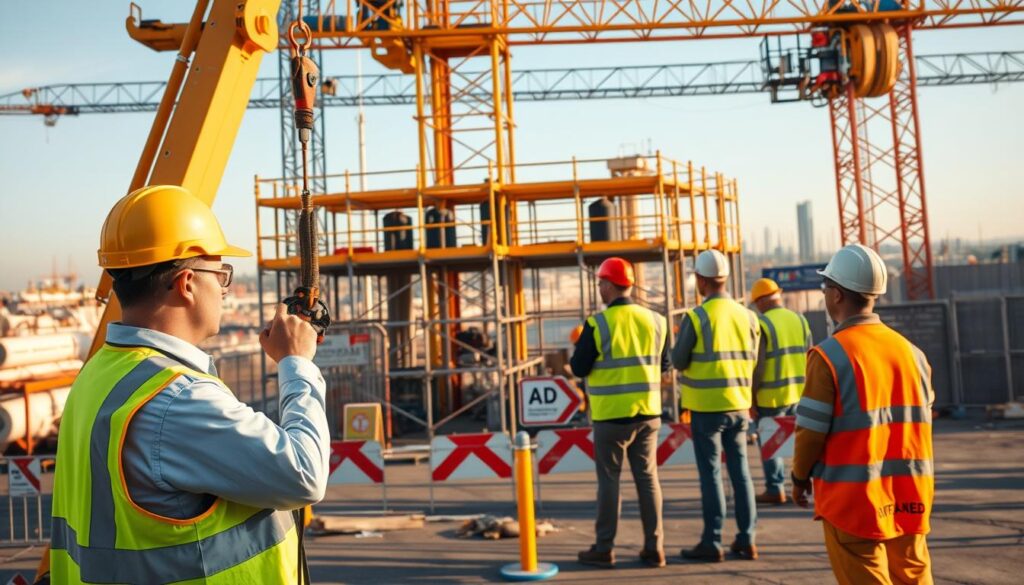Are hazardous conditions on construction sites putting workers at risk? Ensuring the well-being of workers is paramount.
Construction site accidents can be devastating, but many are preventable with the right safety measures in place.
By prioritizing worker safety, companies can reduce risks and create a safer working environment, ultimately protecting their most valuable asset – their workforce.
Key Takeaways
- Understanding the importance of safety guidelines on construction sites.
- Recognizing the role of regulations in preventing accidents.
- Implementing effective safety measures to protect workers.
- Reducing risks through proactive safety planning.
- Creating a safer working environment for all.
Importance of Safety Guidelines in Construction
Safety guidelines play a vital role in the construction industry, contributing to the well-being of workers and the success of projects. By implementing effective safety measures, construction sites can significantly reduce the risk of accidents and enhance overall productivity.
Enhancing Worker Well-Being
The well-being of construction workers is paramount. Safety guidelines help in creating a work environment that prioritizes worker health and safety. This includes providing regular training, ensuring the use of personal protective equipment (PPE), and maintaining a clean and organized workspace.
- Regular training sessions for workers on safety protocols
- Mandatory use of PPE such as helmets, gloves, and safety glasses
- Regular inspections to identify and mitigate potential hazards
Reducing Injury Risks
Construction sites are inherently hazardous, with risks ranging from falls from heights to equipment-related accidents. By adhering to safety guidelines, the risk of injuries can be significantly reduced. This not only protects the workers but also minimizes project delays due to accidents.
- Implementing fall protection systems
- Ensuring proper maintenance of equipment
- Enforcing strict safety protocols during operational hours
Complying with Regulations
Compliance with safety regulations is not only a legal requirement but also a crucial aspect of maintaining a safe working environment. Construction companies must stay updated with the latest regulations and ensure that their safety guidelines are compliant.
Key aspects of compliance include:
- Regularly reviewing and updating safety protocols
- Conducting internal audits to ensure compliance
- Providing documentation of safety measures and training records
By focusing on these areas, construction companies can ensure a safe working environment, reduce the risk of injuries, and comply with regulatory requirements, ultimately contributing to the success of their projects.
Understanding Common Hazards on Construction Sites
Understanding the common hazards associated with construction sites is the first step towards preventing accidents and ensuring worker safety. Construction sites are complex environments with multiple potential dangers.
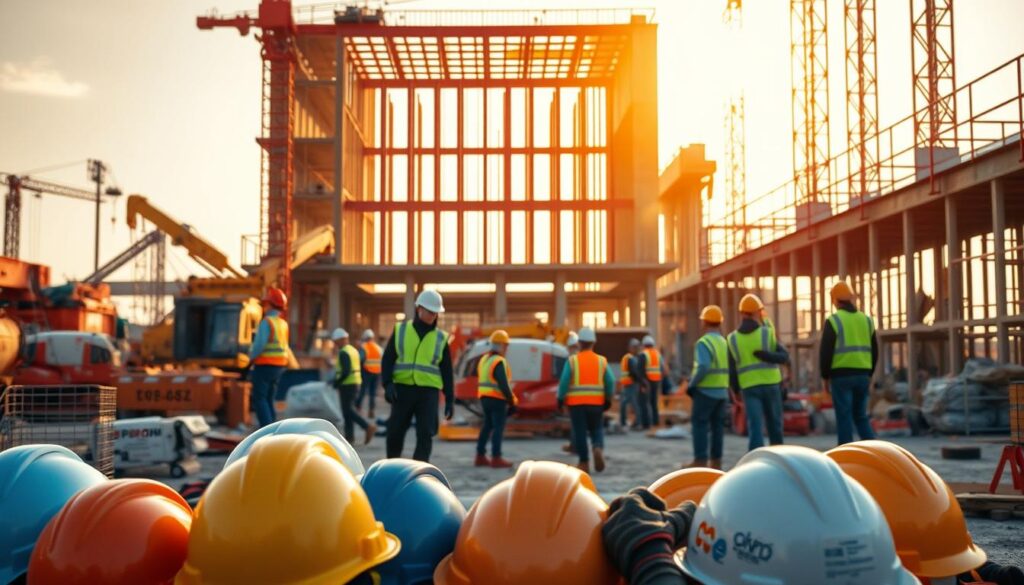
Falls from Heights
Falls from heights are among the most significant risks on construction sites. Workers often perform tasks at elevated levels, making fall protection crucial. Effective fall protection systems include guardrails, safety nets, and personal fall arrest systems.
To mitigate fall risks, it’s essential to ensure that all workers are properly trained in using fall protection equipment and that the equipment is regularly inspected for damage or wear.
Equipment-Related Hazards
Construction sites rely heavily on machinery and equipment, which can be hazardous if not used correctly. Equipment-related hazards include being struck by moving parts, caught between equipment, or crushed by heavy machinery.
- Ensure all operators are properly trained and certified.
- Regularly maintain equipment to prevent mechanical failures.
- Use construction site safety equipment such as safety glasses, gloves, and hard hats to protect workers from potential hazards.
Electrical Hazards
Electrical hazards are another significant risk on construction sites, where workers often encounter exposed wiring, malfunctioning equipment, or overhead power lines. Electrical shock can result in serious injury or death.
To manage electrical hazards, it’s crucial to:
- Ensure all electrical equipment is properly grounded and maintained.
- Use lockout/tagout procedures to prevent accidental startup of machinery.
- Provide workers with training on electrical safety and the use of personal protective equipment (PPE) when working with or near electrical systems.
By understanding and addressing these common hazards, construction sites can significantly reduce the risk of accidents and create a safer working environment for everyone involved.
Personal Protective Equipment (PPE) Requirements
Personal Protective Equipment (PPE) is a cornerstone of construction site safety, protecting workers from various hazards. The effective use of PPE is crucial in preventing injuries and ensuring compliance with OSHA construction site safety guidelines.
Types of PPE for Workers
Different tasks on construction sites require specific types of PPE to mitigate associated risks. Common types of PPE include:
- Hard hats to protect against falling objects
- Safety glasses and goggles to shield eyes from debris
- Gloves to prevent cuts and abrasions
- Steel-toed boots to protect feet from heavy objects
- High-visibility clothing to enhance visibility
- Respiratory protection to prevent inhalation of harmful substances
Employers must ensure that workers have access to the appropriate PPE for their tasks and that it is in good condition.
Proper Usage of PPE
The effectiveness of PPE depends on its proper use and maintenance. Workers should be trained on the correct usage of PPE as part of construction site safety training. This includes:
- Ensuring a proper fit to prevent gaps in protection
- Regularly inspecting PPE for damage or wear
- Storing PPE correctly when not in use to maintain its condition
- Following manufacturer guidelines for use and maintenance
By emphasizing the importance of PPE and ensuring its proper use, construction sites can significantly reduce the risk of injuries and create a safer working environment.
Site Safety Planning and Management
To ensure a safe working environment, construction sites must implement comprehensive safety plans. Effective site safety planning and management are foundational to preventing accidents and ensuring compliance with regulatory standards.
Developing a Safety Plan
A well-structured safety plan is essential for identifying potential hazards and implementing measures to mitigate them. The plan should include a construction site safety checklist to ensure all aspects of site safety are covered. This involves assessing the site for potential risks, outlining emergency response procedures, and establishing protocols for regular safety inspections.
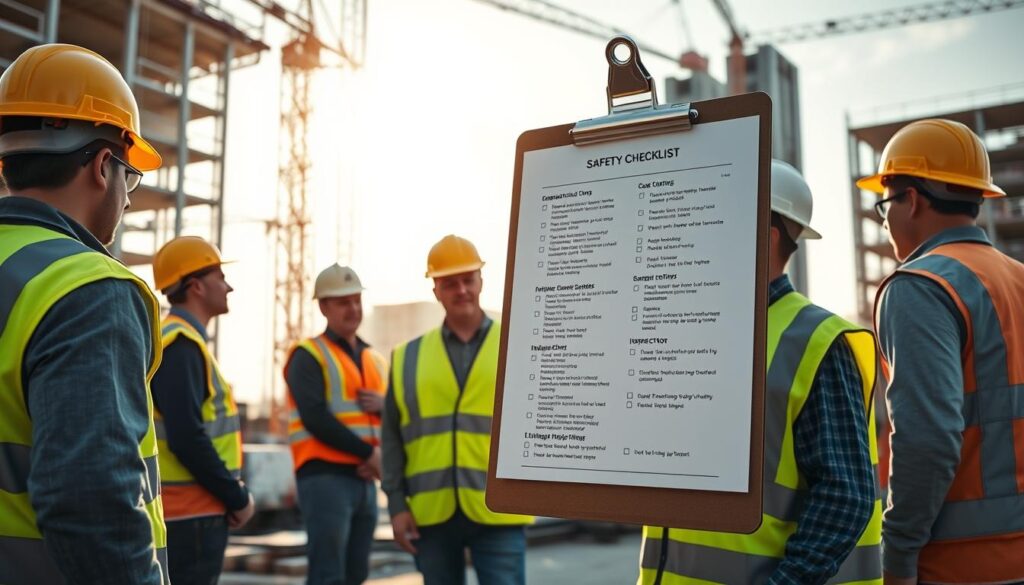
Assigning Responsibilities
Clear assignment of responsibilities is crucial for the successful implementation of a safety plan. Site managers, supervisors, and workers should understand their roles in maintaining site safety. This includes adhering to best practices for construction site safety and participating in regular safety training and drills.
Regular Safety Meetings
Conducting regular safety meetings is a vital component of site safety management. These meetings provide a platform for discussing safety concerns, reviewing incident reports, and reinforcing the importance of safety protocols among all site personnel. By fostering an open dialogue about safety, construction sites can promote a culture of safety awareness and compliance.
By integrating these elements into their safety planning, construction sites can significantly reduce the risk of accidents and enhance overall site safety.
Training and Education for Employees
Effective training and education are crucial for ensuring the safety of employees on construction sites. A well-trained workforce is better equipped to identify potential hazards and take the necessary precautions to prevent accidents.
Onboarding New Workers
The onboarding process for new workers is a critical component of construction site safety training. It is essential to provide new employees with comprehensive training on the site’s safety policies, procedures, and protocols from the outset.
This includes training on the proper use of personal protective equipment (PPE), hazard recognition, and emergency response procedures. A thorough onboarding process helps to ensure that new workers are aware of the potential hazards on the site and know how to mitigate them.
Ongoing Safety Training
Ongoing safety training is vital for keeping workers up-to-date on the latest safety practices and technologies. Regular training sessions can help to reinforce good safety habits and address any new hazards that may have arisen on the site.
Topics covered in ongoing safety training may include updates on regulatory requirements, new equipment operation, and changes to site-specific safety procedures.
Emergency Response Drills
Emergency response drills are an essential component of construction site safety training. These drills help to prepare workers for potential emergencies, such as fires or natural disasters, and ensure that they know how to respond quickly and effectively.
Regular emergency response drills can help to identify areas for improvement and ensure that the site’s emergency response plan is effective.
| Training Topic | Frequency | Description |
|---|---|---|
| Hazard Recognition | Monthly | Training on identifying potential hazards on the construction site |
| PPE Usage | Quarterly | Training on the proper use and maintenance of personal protective equipment |
| Emergency Response | Bi-Annually | Training on responding to emergencies, such as fires or natural disasters |
Daily Safety Inspections and Checklists
Construction sites can significantly reduce accidents by implementing a rigorous daily safety inspection routine. This proactive approach helps in identifying and mitigating potential hazards before they become major issues.
Importance of Routine Inspections
Routine inspections are crucial for maintaining a safe working environment. They help in detecting equipment malfunctions, ensuring compliance with safety regulations, and promoting a culture of safety among workers.
Regular inspections can identify potential hazards such as falls from heights, equipment-related hazards, and electrical hazards, allowing for timely interventions.
Common Items to Check
A comprehensive daily safety inspection should include checking the condition of personal protective equipment (PPE), ensuring that machinery and equipment are properly maintained, and verifying that the site is clean and free from clutter.
- Inspecting scaffolding and ladders for damage or wear
- Checking electrical cords and equipment for signs of damage
- Ensuring that fire extinguishers are accessible and fully charged
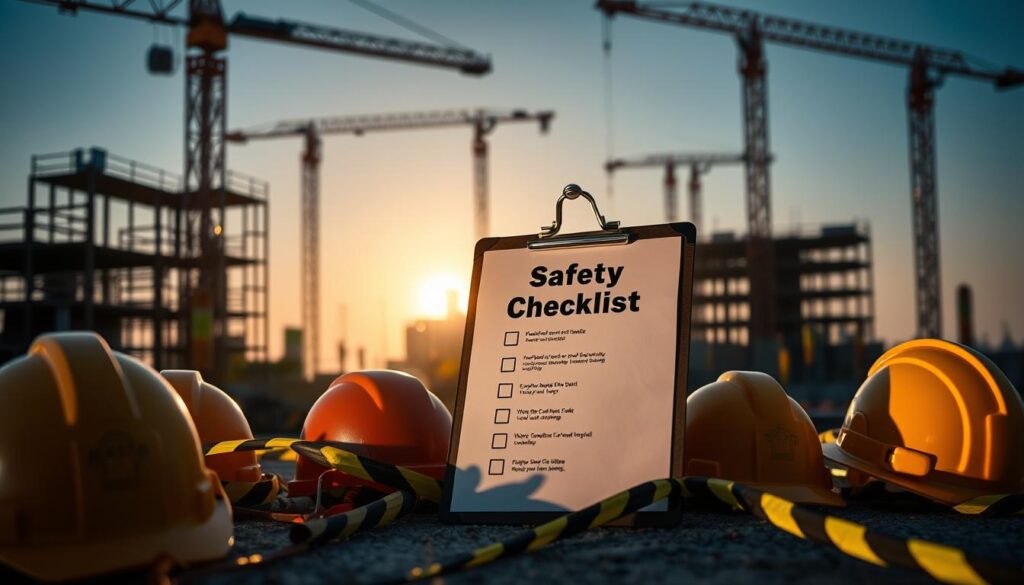
Maintaining Documentation
Maintaining detailed records of daily safety inspections is essential for compliance with construction site safety regulations and for tracking improvements in safety practices over time.
Documentation should include the date and time of the inspection, items checked, any hazards identified, and corrective actions taken. This information is invaluable for future reference and for conducting safety audits.
By prioritizing daily safety inspections and maintaining thorough checklists, construction sites can significantly enhance their safety protocols and reduce the risk of accidents.
Safe Equipment Operation Practices
The safe operation of equipment is a cornerstone of construction site safety. Ensuring that all equipment is operated safely requires a multi-faceted approach that includes proper training, regular maintenance, and vigilant monitoring for any signs of equipment deficiencies.
Operator Training and Competence
Training operators on the proper use of equipment is fundamental to safe equipment operation. Operators should be trained not only on the specific equipment they will be using but also on general safety practices and emergency procedures. This training should include both theoretical knowledge and practical experience, ensuring that operators are competent and confident in their ability to operate equipment safely.
Key aspects of operator training include:
- Understanding the equipment’s controls and functions
- Learning safe operating procedures
- Practicing under supervision
- Receiving feedback on performance
Regular Maintenance for Optimal Performance
Regular maintenance is critical to ensuring that equipment remains in good working condition. This involves routine checks, scheduled maintenance tasks, and prompt repairs when needed. Maintenance not only prevents equipment failure but also ensures that the equipment operates efficiently, reducing the risk of accidents caused by malfunctioning equipment.
A well-maintained piece of equipment is less likely to be involved in an accident. Regular maintenance checks should be documented, and records should be kept to track the maintenance history of each piece of equipment.
| Maintenance Task | Frequency | Responsible Person |
|---|---|---|
| Daily Inspection | Daily | Operator |
| Scheduled Maintenance | Monthly/Quarterly | Maintenance Team |
| Repair/Replacement | As Needed | Maintenance Team |
Identifying and Addressing Equipment Deficiencies
Identifying equipment deficiencies before they become major issues is crucial for maintaining a safe working environment. Operators and maintenance personnel should be vigilant for signs of wear, damage, or malfunction. Any deficiencies identified should be reported and addressed promptly to prevent accidents.
https://www.youtube.com/watch?v=ONo-QxHJCvw
By focusing on safe equipment operation practices, construction sites can significantly reduce the risk of equipment-related accidents, enhancing overall site safety and productivity.
Implementing Fall Protection Systems
Implementing effective fall protection systems is essential for minimizing risks and ensuring a safe working environment on construction sites. Falls are a significant hazard, and according to OSHA construction site safety guidelines, fall protection is a critical component of workplace safety.
Understanding Fall Protection Types
There are several types of fall protection systems that can be implemented on construction sites. These include guardrail systems, personal fall arrest systems (PFAS) involving harnesses and lanyards, and safety net systems. Each type has its specific applications and benefits.
Guardrail Systems are one of the most effective methods for preventing falls. They are sturdy barriers installed around the perimeter of elevated work areas.
Effective Guardrail Systems
To be effective, guardrail systems must be installed correctly and meet specific safety standards. This includes being of sufficient height, having a certain level of strength, and being free from any gaps or weaknesses that could allow a worker to fall through or be caught.
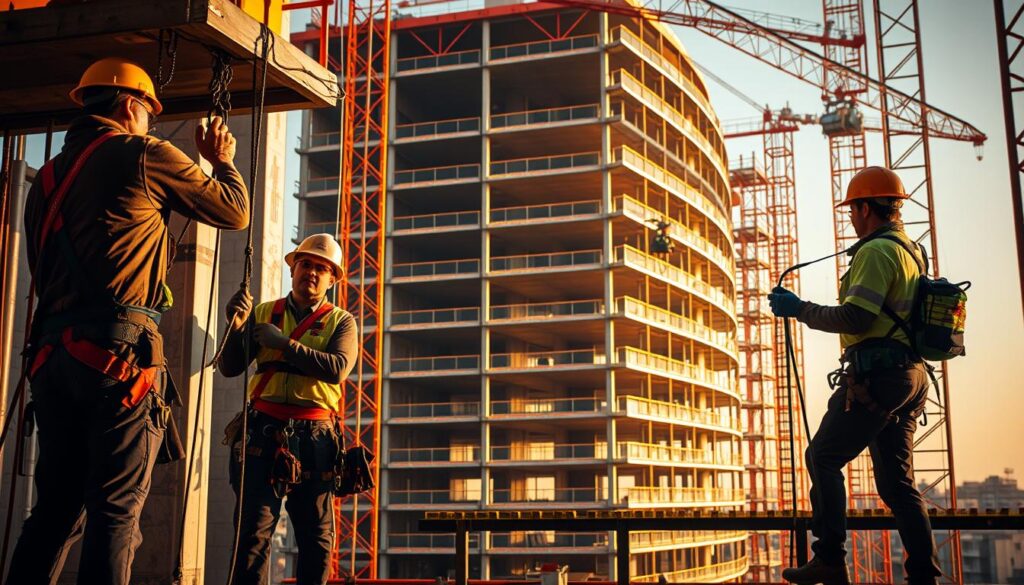
Harness and Lanyard Usage
Personal fall arrest systems, which include harnesses and lanyards, are crucial for protecting workers who are at risk of falling. Proper usage involves ensuring that the harness fits the worker correctly and that the lanyard is attached to a secure anchor point.
It’s also vital to inspect harnesses and lanyards regularly for any signs of wear or damage, as part of a comprehensive construction site safety tip.
By understanding and implementing these fall protection systems, construction sites can significantly reduce the risk of falls, thereby protecting workers and complying with OSHA construction site safety guidelines.
Fire Safety Protocols on Construction Sites
Construction sites are inherently vulnerable to fire hazards, making it crucial to implement effective fire safety measures. Fires can lead to significant losses, including damage to property, equipment, and potentially severe injuries or fatalities. Therefore, having comprehensive fire safety protocols in place is essential for ensuring a safe working environment.
Fire Extinguisher Placement
One of the critical components of fire safety on construction sites is the strategic placement of fire extinguishers. These devices must be easily accessible, regularly inspected, and appropriately rated for the types of fires likely to occur in the area. For instance, Class A extinguishers are used for ordinary combustibles, Class B for flammable liquids, and Class C for electrical fires. Ensuring that workers are aware of the location and proper use of fire extinguishers is vital.
Evacuation Plans
Having a well-defined evacuation plan is crucial in case of a fire emergency. This plan should include clearly marked exit routes, designated assembly points outside the construction site, and a system for alerting workers of a fire. Regular drills should be conducted to ensure that all workers are familiar with the evacuation procedure, and it should be reviewed and updated as necessary.
Flammable Materials Handling
The safe handling and storage of flammable materials are key to preventing fires on construction sites. This includes storing flammable liquids in approved containers and cabinets, keeping them away from ignition sources, and ensuring that areas where flammable materials are used or stored are well-ventilated. Workers handling these materials should be trained on the associated risks and the proper safety procedures.
By implementing these fire safety protocols, construction sites can significantly reduce the risk of fire-related incidents, ensuring a safer environment for everyone involved. It’s about creating a culture of safety that prioritizes prevention and preparedness.
Hazard Communication Standards
Hazard communication standards play a vital role in protecting workers from the dangers associated with chemicals and hazardous materials on construction sites. By ensuring that workers are aware of the hazards and know how to handle them safely, construction sites can significantly reduce the risk of accidents and injuries.
Proper Labeling of Chemicals
Proper labeling of chemicals is a critical component of hazard communication. It involves clearly identifying the contents of chemical containers and providing information about their hazards. This is typically achieved through the use of labels and Safety Data Sheets (SDSs).
According to the Occupational Safety and Health Administration (OSHA), labels should include the product identifier, signal word, hazard statement, precautionary statement, and pictogram. For example, a label for a hazardous chemical might include a signal word like “Danger” and a hazard statement such as “Causes severe skin burns and eye damage.”
Key Elements of Chemical Labeling:
- Product identifier
- Signal word
- Hazard statement
- Precautionary statement
- Pictogram
| Label Element | Example |
|---|---|
| Product Identifier | Chemical XYZ |
| Signal Word | Danger |
| Hazard Statement | Causes severe skin burns and eye damage |
Effective Training on Hazardous Materials
Effective training on hazardous materials is equally important. Workers need to understand the hazards associated with the chemicals they work with and know how to handle them safely. This includes knowing how to read labels and SDSs, understanding the different types of hazards (such as flammable, corrosive, or toxic), and being aware of the necessary personal protective equipment (PPE).
“Training is not just about compliance; it’s about ensuring that workers have the knowledge they need to stay safe on the job.” – OSHA
Training programs should be comprehensive and include both classroom instruction and hands-on training. They should also be regularly updated to reflect any changes in the workplace or new hazards.
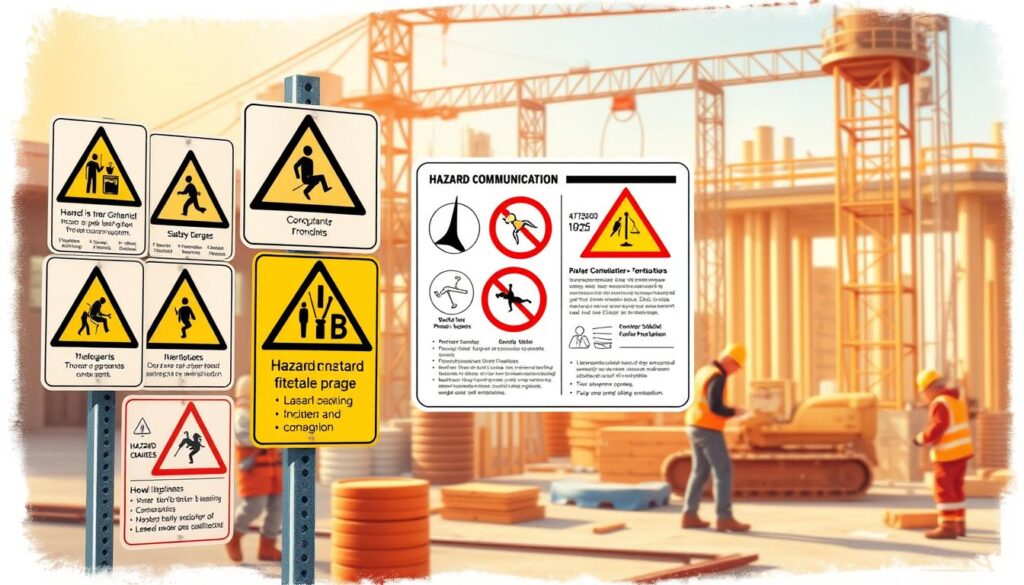
Effective Site Access and Traffic Control
A well-planned site access and traffic control system is essential for reducing the risk of accidents on construction sites. This involves implementing various construction site safety measures to manage the flow of pedestrians, vehicles, and equipment.
Managing pedestrian safety is a critical component of site access control. Pedestrians, including workers and visitors, need to be protected from vehicular traffic and other hazards. This can be achieved by designating specific pedestrian pathways and ensuring they are clearly marked and separated from traffic routes.
Managing Pedestrian Safety
To enhance pedestrian safety, construction sites should:
- Implement clear signage to direct pedestrians to safe pathways.
- Use barricades to separate pedestrian paths from vehicular traffic.
- Ensure adequate lighting in pedestrian areas.
Vehicle and Equipment Movement
Controlling vehicle and equipment movement is vital to prevent collisions and other accidents. This includes:
- Establishing one-way traffic routes where possible.
- Implementing speed limits for vehicles on site.
- Ensuring all operators are trained and certified.
By controlling vehicle and equipment movement, construction sites can significantly reduce the risk of accidents, thereby enhancing overall construction site safety tips.
Signage and Barricade Usage
Effective use of signage and barricades is crucial for demarcating safe zones and hazardous areas. This includes:
- Using clear and visible signs to indicate hazards and safe routes.
- Employing barricades to block off hazardous areas.
- Regularly inspecting and maintaining signage and barricades.
By implementing these construction site safety measures, construction sites can ensure a safer environment for everyone on site.
Responding to Accidents and Emergencies
Having a robust emergency response plan is essential for minimizing the effects of accidents on construction sites. Accidents can occur despite the best safety measures, and being prepared is crucial for ensuring the safety of workers and preventing future incidents.
First Aid Procedures
First aid is a critical component of any emergency response plan. Construction sites must have trained personnel and adequate first aid supplies on hand. Proper training in first aid can significantly reduce the severity of injuries. It’s also important to regularly inspect and update first aid kits to ensure they are fully stocked and easily accessible.
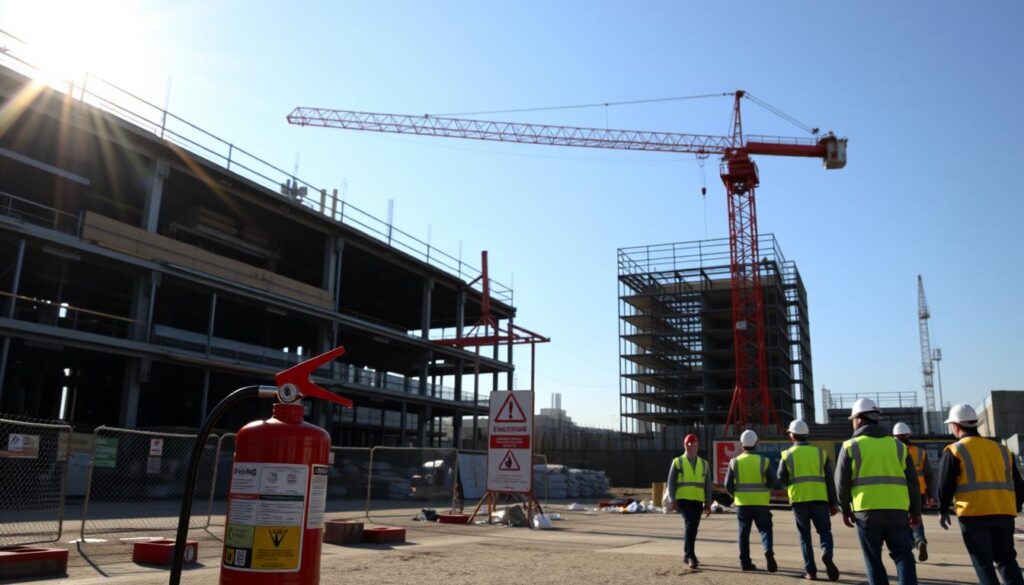
Emergency Contact Procedures
In the event of an accident, having clear emergency contact procedures is vital. This includes having a list of emergency contact numbers readily available, such as local emergency services and site-specific emergency contacts. Effective communication during an emergency can save lives and reduce the impact of the incident.
Investigative Protocols
After an accident, it’s crucial to conduct a thorough investigation to determine the cause. Investigative protocols should be in place to ensure that all incidents are properly documented and analyzed. This not only helps in identifying the root cause but also in implementing measures to prevent similar accidents in the future. Learning from incidents is a key aspect of improving construction site safety.
By having comprehensive procedures in place for responding to accidents and emergencies, construction sites can better protect their workers and reduce the risk of future incidents. This proactive approach is in line with the importance of construction site safety and adheres to construction site safety regulations.
Mental Health and Well-Being on Site
Mental health support is becoming a critical component of overall safety protocols on construction sites. As the industry continues to evolve, it’s essential to address the mental well-being of workers alongside their physical safety.
Recognizing Signs of Stress
Recognizing the signs of stress and mental health issues among construction workers is the first step towards creating a supportive environment. Common indicators include changes in behavior, decreased productivity, and increased absenteeism. By being aware of these signs, supervisors and colleagues can offer timely support.
Promoting a Supportive Environment
Promoting a supportive work environment involves fostering an open culture where workers feel comfortable discussing their mental health. Regular safety meetings can include discussions on mental well-being, and supervisors should be trained to handle such conversations sensitively.
Creating a supportive environment also means ensuring that workers have access to necessary resources and that their workload is manageable. Effective workload management can significantly reduce stress levels.
Resources for Workers
Providing resources for workers struggling with mental health is crucial. This can include access to counseling services, mental health days, and training for supervisors to identify and support workers in need. Partnering with mental health organizations can also provide additional resources and support.
By implementing these strategies, construction companies can not only improve the well-being of their workers but also enhance overall productivity and safety on site. It’s about creating a culture that values mental health as much as physical safety.
Promoting a Culture of Safety
Creating a culture of safety is paramount for construction companies to ensure a safe working environment. This involves more than just implementing safety protocols; it requires a mindset shift where every employee feels responsible for safety.
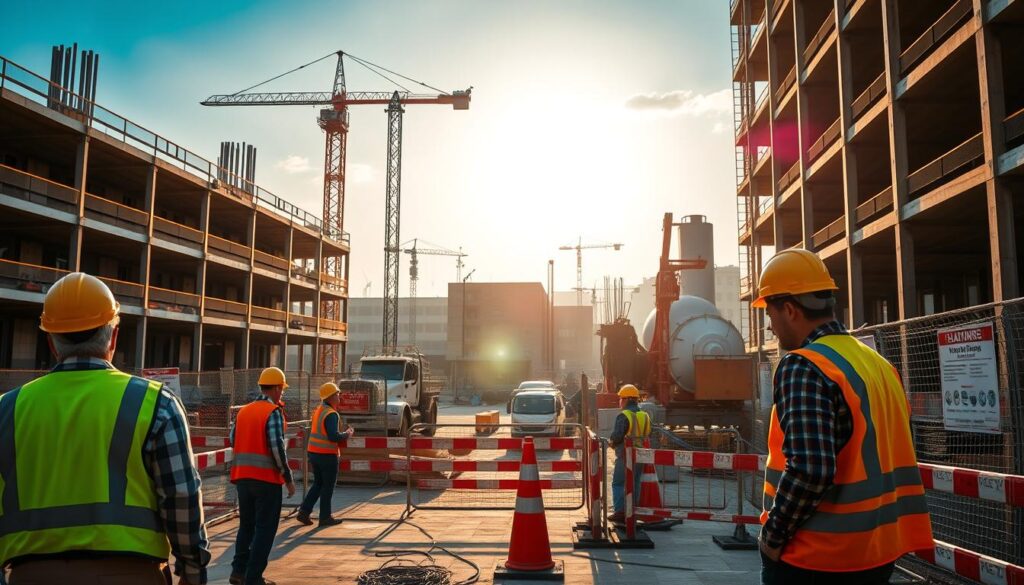
Encouraging Reporting of Unsafe Conditions
One of the key elements of a safety culture is encouraging workers to report unsafe conditions without fear of reprisal. This can be achieved by establishing clear reporting channels and ensuring that all reports are taken seriously and acted upon promptly.
“Safety is everyone’s responsibility.” This mantra should be echoed throughout the construction site, fostering an environment where workers feel empowered to speak up when they see something that could potentially harm them or their colleagues.
Recognizing Safe Practices
Recognizing and rewarding safe practices is another crucial aspect of promoting a culture of safety. By acknowledging workers who adhere to safety protocols and contribute to a safe working environment, construction companies can reinforce positive behaviors.
- Regular safety awards
- Public recognition during safety meetings
- Incentives for safety milestones
These measures not only motivate individual workers but also set a standard for the entire team, emphasizing the importance of construction site safety.
Involving All Employees in Safety Discussions
Involving all employees in safety discussions is vital for a robust safety culture. This includes regular safety meetings, training sessions, and open forums where workers can discuss their concerns and suggestions.
“The safety of our workers is our top priority. We achieve this by listening to their feedback and continuously improving our safety protocols.”
By engaging all employees in safety discussions, construction companies can tap into the collective knowledge and experience of their workforce, leading to more effective safety practices.
Promoting a culture of safety is an ongoing effort that requires commitment and dedication from everyone involved in construction projects. By encouraging the reporting of unsafe conditions, recognizing safe practices, and involving all employees in safety discussions, construction companies can create a safer, more productive work environment.
Continuous Improvement and Safety Audits
Maintaining a safe construction site requires ongoing effort and commitment. Regular safety audits play a crucial role in identifying potential hazards and ensuring compliance with OSHA construction site safety guidelines.
Regular Audits for Enhanced Safety
Safety audits help construction companies evaluate their current safety protocols and identify areas for improvement. By using a comprehensive construction site safety checklist, site managers can ensure that all necessary safety measures are in place.
Learning from Incidents
When incidents occur, it’s essential to conduct thorough investigations to understand the root causes. This information can then be used to update safety protocols and prevent similar incidents from happening in the future.
Updating Safety Protocols
Safety protocols should be regularly reviewed and updated to reflect changing site conditions, new equipment, and updated regulations. This proactive approach helps ensure that construction sites remain safe and compliant with relevant guidelines.
By adopting a culture of continuous improvement, construction companies can stay ahead of potential safety issues and maintain a safe working environment for all employees.
